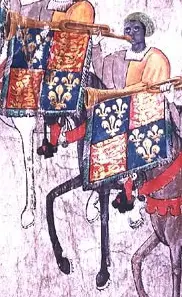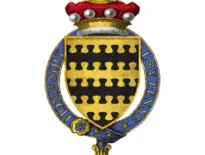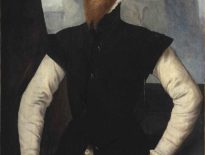 John Blanke was a royal trumpeter and was employed as a musician at the court of Henry VII and Henry VIII, his first appearance at court being recorded in 1507. It is believed that John Blanke was of African descent; however, sadly, his age, date of birth, parentage, and place of birth all remain unknown to us.
John Blanke was a royal trumpeter and was employed as a musician at the court of Henry VII and Henry VIII, his first appearance at court being recorded in 1507. It is believed that John Blanke was of African descent; however, sadly, his age, date of birth, parentage, and place of birth all remain unknown to us.
It appears that John Blanke was part of a larger trend in Europe at the time in which rulers tended to employ African musicians. It is believed that this happened from as early as 1194 when it is documented that turbaned black trumpeters were involved in the procession of Henry VI, Holy Roman Emperor, into Palermo in Sicily. Scholars have suggested that Blanke arrived in England alongside Katherine of Aragon as part of her retinue when she came to marry Prince Arthur in 1501. Although we have evidence for an African presence in her retinue, there is no record of John Blanke being a member, so this is speculative. Also, given the fact that the Tudor court employed musicians from all over Europe, Blanke could have come from Spain, Portugal, or Italy, as these countries had an increasingly large African population.
Between 1507 and 1512, Blanke was one of eight royal trumpeters and enjoyed a high-status occupation. We have records of his first payment, made to him in early December of the year 1507, where he was paid 8d a day for his work the previous month. John Blanke was present at the funeral of Henry VII on 11th May 1509, where he played the trumpet, and again at the coronation of Henry VIII on 24th June. Following his involvement in these events, Blanke asked for a pay rise, petitioning the king to grant him position left vacant by the death of Domynck Justinian, and the wage of 16d per day. He said to the king that his current wages were:
‘not sufficient to mayntaigne and kepe hym to doo your grace lyke service as other your trompeters doo’ (TNA:PRO, E101/417/2 no, 105).
He also implored the king to listen to him and consider his “true and faithful service”, stating that he would continue serving the king until the end of his life. On 12th and 13th February 1511, we know that John Blanke played at the Westminster Tournament. This was a joust held to celebrate the birth of Henry VIII’s son, Henry, Duke of Cornwall, who was born on New Year’s Day, but who sadly died later that February. It is believed that at this tournament, trumpeters would have been given ten times their daily wage. You can see depictions of John Blanke in the 60-foot-long Westminster Tournament roll of 1511. This was produced in the workshop of Thomas Wriothesley, who held the position of Garter King of Arms. John Blanke is first depicted as riding a grey horse with a black harness. The trumpeters wear yellow and grey livery, and John Blanke is shown wearing a turban, which is brown and yellow at first. The trumpeters appear a second time at the end of the jousting. In this depiction, John Blanke’s horse is black with a crimson harness, and the weird part of this depiction is that he has one visible hand, which is shown as white. This contrasts with his face and looks exceptionally out of place. We also notice that his turban has changed colour in the second depiction and is green and gold.
We know that John Blanke married in January 1512; however, the identity of his wife remains a mystery. Henry VIII even sent him a wedding gift, writing to the great wardrobe on 14th January ordering them to deliver to ‘John Blak, our trumpeter…to be taken of our gift against his marriage’ a garment of violet cloth with a bonnet and a hat (PRO: TNA, E101/417/6, no.50). After this gift, however, we hear nothing more of John Blanke in the royal records, and he is seemingly uninvolved in the event which listed trumpeters on 31st January 1514.
John Blanke is one of, if not the only, identifiable black person portrayed in 16th-century British art. The fact that he achieved a prominent position in a royal household, was married, earned wages, and, what’s more, negotiated with the king about these wages, all suggest that John Blanke was not a slave. His connection to Henry VII and Henry VIII, alongside his presence in court, have made John Blanke the most widely acknowledged example of an African presence in Tudor England.
By Georgia Whitehead
Georgia has just finished her masters in Classics at the University of Edinburgh. Academically, Georgia is interested in early Christianity, with her master's thesis focusing on "The Male Gaze and Self-Representation in Female Christian Narratives". In addition to her interest in ancient history, she has always been an avid lover of the Tudor era, drawn to the magnificence of the Tudor courts and the larger than life characters. She is particularly interested in The Reformation, Christianity and the shifting sands of ecclesiastical politics in this period and also has a keen interest in the lives of Tudor women. It is Georgia's ambition to become a writer, perhaps publishing her own Tudor novel one day.
Georgia also runs a history blog and instagram page called Historia Mundis.
Bibliography
- Onyeka. Blackamoores: Africans in Tudor England, their Presence, Status and Origins, London. Narrative Eye, 2013.
- Miranda Kaufmann, “John Blanke, the Trumpeter”, in Black Tudors: The Untold Story, Oneworld Publications, 2017, pp. 7–31.
- Miranda Kaufmann, “Blanke, John (fl. 1507–1512), royal trumpeter", Oxford Dictionary of National Biography.
- National Archives: https://www.nationalarchives.gov.uk/education/resources/significant-people-collection/john-blanke/



I was reading his story in Black Tudors by Miranda Kaufmann again the other day which starts with the story of John Blanke. His depiction in the Westminster Tournament Tapestry is wonderful. There are also three drummers of African origins. It’s just what we should be doing telling the full story of Black people in European and American society, that they didn’t all arrive on slave ships or work as servants, some had very responsible and authoritative positions. That records go back to the twelfth century is amazing. Thanks for sharing this inspirational story.